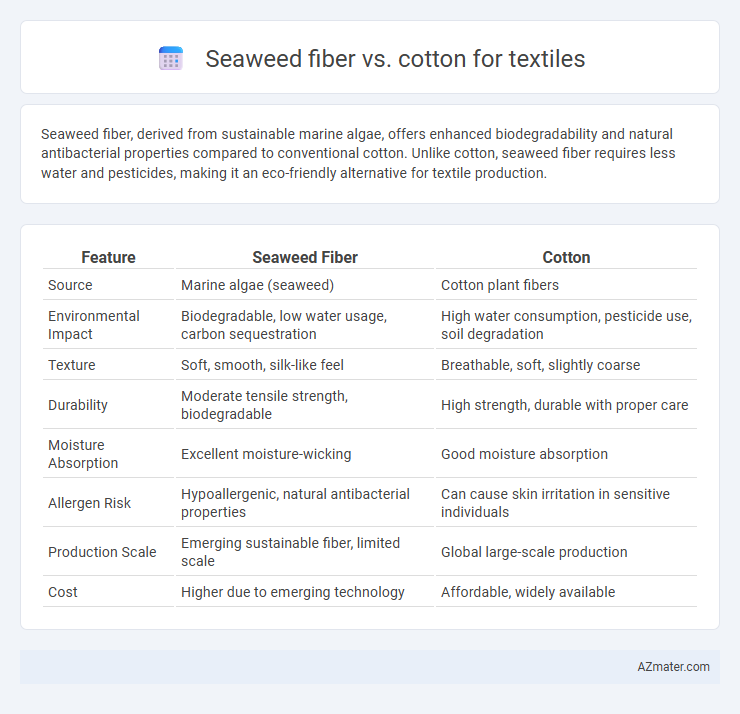Seaweed fiber, derived from sustainable marine algae, offers enhanced biodegradability and natural antibacterial properties compared to conventional cotton. Unlike cotton, seaweed fiber requires less water and pesticides, making it an eco-friendly alternative for textile production.
Table of Comparison
| Feature | Seaweed Fiber | Cotton |
|---|---|---|
| Source | Marine algae (seaweed) | Cotton plant fibers |
| Environmental Impact | Biodegradable, low water usage, carbon sequestration | High water consumption, pesticide use, soil degradation |
| Texture | Soft, smooth, silk-like feel | Breathable, soft, slightly coarse |
| Durability | Moderate tensile strength, biodegradable | High strength, durable with proper care |
| Moisture Absorption | Excellent moisture-wicking | Good moisture absorption |
| Allergen Risk | Hypoallergenic, natural antibacterial properties | Can cause skin irritation in sensitive individuals |
| Production Scale | Emerging sustainable fiber, limited scale | Global large-scale production |
| Cost | Higher due to emerging technology | Affordable, widely available |
Introduction to Seaweed Fiber and Cotton in Textiles
Seaweed fiber, derived from sustainable marine algae, offers a biodegradable and eco-friendly alternative to traditional textiles, rich in micronutrients and possessing natural antibacterial properties. Cotton, a widely utilized natural fiber from the Gossypium plant, is valued for its softness, breathability, and versatility in textile production but involves intensive water and pesticide use. The integration of seaweed fibers in textiles addresses environmental concerns linked to cotton farming while providing innovative fabric functionality for sustainable fashion.
Sustainable Sourcing: Seaweed Fiber vs Cotton
Seaweed fiber offers a sustainable alternative to cotton by requiring less water, no pesticides, and benefiting from rapid growth in marine environments, reducing land use and runoff pollution. Cotton cultivation demands significant freshwater and chemical inputs, often leading to soil degradation and increased carbon emissions, which challenge its environmental sustainability. The renewable nature of seaweed and minimal resource requirements position seaweed fiber as a promising eco-friendly material for textile production.
Environmental Impact Comparison
Seaweed fiber offers a significantly lower environmental footprint compared to cotton, requiring minimal freshwater and no pesticides, which reduces soil degradation and water pollution. Cotton cultivation consumes approximately 20,000 liters of water per kilogram, while seaweed is grown in marine environments without freshwater or synthetic fertilizers. The biodegradability of seaweed fiber further minimizes landfill waste, making it a more sustainable choice for eco-friendly textiles.
Manufacturing Processes and Resource Consumption
Seaweed fiber manufacturing involves biochemical extraction and drying processes that demand less water and pesticides compared to traditional cotton farming, which requires extensive irrigation, soil preparation, and chemical inputs. Seaweed cultivation relies on ocean resources without arable land use, significantly reducing land degradation and carbon emissions associated with cotton agriculture. Textile production from seaweed fiber generates lower environmental impact and resource consumption, offering a sustainable alternative to cotton's intensive manufacturing footprint.
Physical Properties and Performance
Seaweed fiber exhibits superior moisture absorption and antimicrobial properties compared to cotton, enhancing comfort and hygiene in textile applications. It offers remarkable tensile strength and elasticity, making it durable and resistant to wear while maintaining lightweight softness similar to cotton. Unlike cotton, seaweed fiber demonstrates enhanced UV protection and biodegradability, contributing to sustainable and long-lasting textile performance.
Comfort and Wearability Factors
Seaweed fiber offers superior moisture-wicking properties and natural antibacterial benefits, enhancing comfort and reducing odor compared to traditional cotton fabrics. Its lightweight and breathable texture ensures better air circulation, making it ideal for activewear and sensitive skin. Cotton remains valued for its softness and durability, but seaweed fiber's eco-friendly nature and enhanced wearability present a compelling alternative in sustainable textile innovation.
Biodegradability and End-of-Life Considerations
Seaweed fiber exhibits superior biodegradability compared to conventional cotton, breaking down naturally in marine and soil environments within weeks due to its organic composition and absence of synthetic additives. Cotton, while biodegradable, often requires longer degradation times and may involve pesticide residues that impact environmental safety during decomposition. End-of-life considerations favor seaweed fiber textiles as they minimize ecological footprint through rapid biodegradation and contribute to a circular economy by reducing landfill accumulation and microplastic pollution.
Cost and Commercial Availability
Seaweed fiber offers a sustainable alternative to cotton, but its commercial availability remains limited compared to the well-established cotton market. In terms of cost, seaweed fiber production is currently more expensive due to specialized extraction processes and lower scale manufacturing. Cotton dominates the textile industry with widespread availability and cost-effectiveness, making it the preferred choice for mass production despite environmental concerns.
Market Trends and Consumer Preferences
Seaweed fiber is gaining traction in the textile market due to its sustainability and biodegradability, appealing to eco-conscious consumers seeking natural alternatives to conventional fabrics. Cotton remains dominant because of its softness, breathability, and established supply chains, but concerns about water usage and pesticide reliance are driving shifts toward innovative fibers like seaweed. Market trends indicate growing investment in seaweed fiber development, with consumer preference leaning towards sustainable textiles without compromising comfort and quality.
Future Outlook: Innovations and Industry Adoption
Seaweed fiber offers a sustainable alternative to cotton by reducing water consumption and enhancing biodegradability in textile production. Innovations in seaweed fiber extraction and blending technologies are accelerating its adoption among eco-conscious fashion brands seeking to minimize environmental impact. The industry anticipates increased scalability and cost-effectiveness, positioning seaweed fiber as a key material in the future of sustainable textiles.

Infographic: Seaweed fiber vs Cotton for Textile
 azmater.com
azmater.com